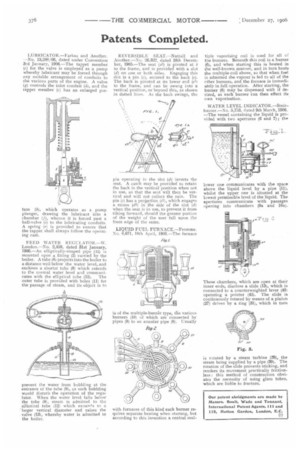Patents Completed.
Page 24

If you've noticed an error in this article please click here to report it so we can fix it.
LIJBWICATOR.—Farkas and Another. —No. 13,288/06, dated under Convention 3rd January, 1906.—The tappet member (c) for the valve is employed as a pump whereby lubricant may be forced through any suitable arrangement of conduits to the various parts of the engine. A valve (g) controls the inlet conduit 1h), and the tappet member (c) has an enlarged par tion (6), which operates as a pump plunger, drawing the lubricant into a chamber (f), whence it is forced past a hall-valve (i) to the lubricating conduits. A spring (r) is provided to ensure that the tappet shall always follow the operating cam.
FEED WATER REGULATOR.—W. Loudon.—No. 2,459, dated 31st January, 1906.—An elliptically-shaped pipe (121 is mounted upon a fitting (2) carried by the boiler. A tube (8) projects into the boiler to a distance well below the water level, and encloses a shorter tube 19) which extends to the normal water level and communi cates with the elliptical tube (12). The outer tube is provided with holes (11) for the passage of steam, and its object is to prevent the water from bubbling at the entrance of the tube (9), as such bubbling would disturb the operation of the regulator. When the water level falls below the tube (9), steam is admitted to the elliptical tube (12) which exrianits to a 'larger vertical diameter and raises the valve (13), whereby water is admitted to the boiler.
REVERSIBLE SEAT.—Nuttall and Another.—No. 26,322, dated 18th December, 1905.—The seat (122) is pivoted at to the frame, and is provided with a slot (d) on one or both sides. Engaging this slot is a pin (c), secured to the back (e). The back is pivoted at its lower end (e-ti to the frame, and can be swung into a vertical position, or-beyond this, as shown in dotted lines. As the back swings, the pin operating in the slot (d) inverts the seat. A catch may be provided to retain the back in the vertical position when not in use, so that the seat will then be vertical and will not collect the rain. The pin (c) has a projection 01, which engages a recess (di) in the side of the slot (d) when the seat is in use, to prevent it from tilting forward, should the greater portion of the weight of the user fall upon the front edge of the same.
LIQUID FUEL FURNACE.--Fromme. No. 8,671, 111th April, 1906.—The furnace
is of the multiple-burner type, the various burners (10) of which are connected by pipes (9) to an annular pipe (8). Usually with furnaces of this kind each burner requires separate heating when starting, but according to this invention a central. mul
tipie vaporising coil is used for all of toe burners. Beneath this coil is a burner (6), and when starting this is heated in the well-known manner, and in turn heats the multiple coil above, so that when fuel is admitted the vapour is fed to all of the ether burners, and the furnace is immediately in full operation. After starting, the burner (6) may be dispensed with if desired, as each burner can then effect it own vaporisation.
WATER LEVEL INDICATOR.—Steinhauser,—No. 5,753, dated 9th March, 1906. —The vessel containing the liquid is provided with two apertures (6 and 7); the
lower one communicates with the space above the liquid level by a pipe (11), whilst the upper one is situated at the lowest permissible level of the liquid. The apertures communicate with passages opening into chambers (9a and 10a).
These chambers, which are open at their inner ends, disclose a slide (13), which is connected to a counterweighted lever (40) operating a pointer (421. The slide is continuously rotated by means of a pinion (27) driven by a ring (31), which in turn is rotated by a steam turbine (n), the steam being supplied by a pipe (39). The rotation of the slide prevents sticking, and renders its movement practically frictionless : this method of construction obviates the necessity of using glass tubes, which are liable to fracture.
























